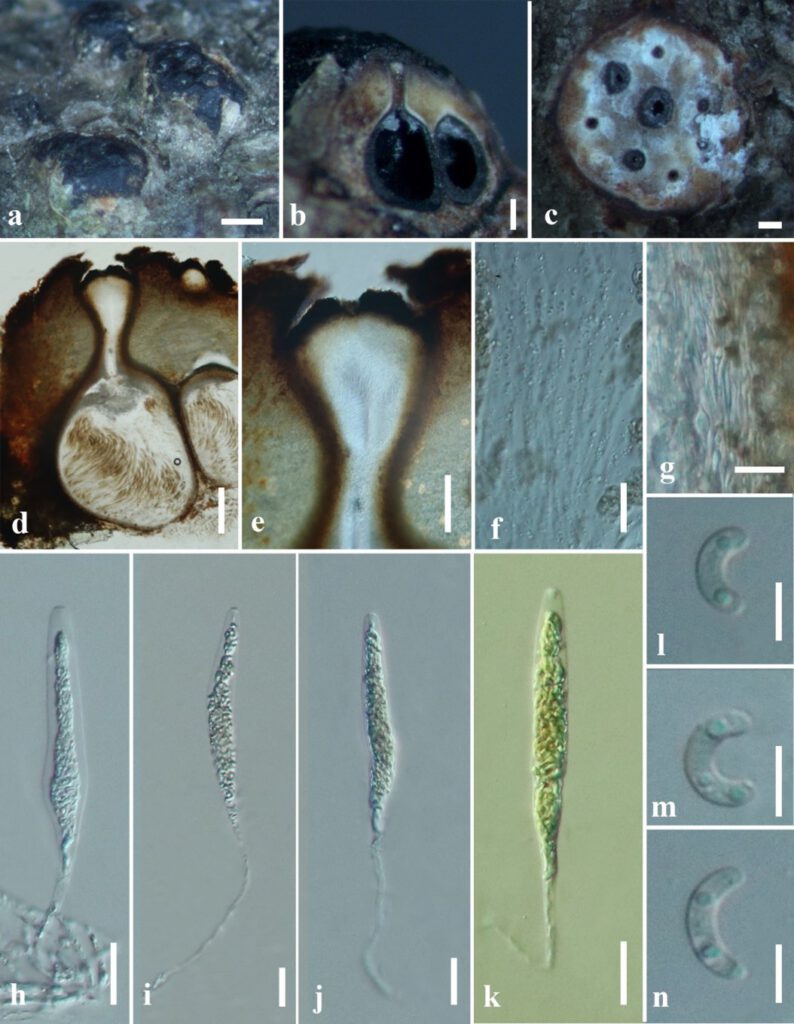Diatrypella quercina (Pers.) Cooke, J. Bot., Lond. 4: 99 (1866)
Index Fungorum number: IF 215896; MycoBank number: MB 215896; Facesoffungi number: FoF 11778;
Saprobic on dead twigs on Quercus robur. Sexual morph: Stromata 1.0–1.5 mm in diam., well-developed, solitary to gregarious, erumpent, black, immersed, globose to subglobose. Ascomata 610–660 μm high, 550–600 μm diam. (x̄ = 650 × 580 μm, n = 10), perithecial, surrounded by white entostroma, 6–8 perithecia arranged in a valsoid configuration, conical, individual ostiole with a long neck. Neck 450–490 μm long (x̄ = 480 μm, n = 10), cylindrical, with periphyses. Peridium 20–30 μm wide (x̄ = 26 μm, n = 10), composed outermost layers of brown, thick-walled cells in textura angularis, inner layers hyaline, cells forming of textura prismatica. Hamathecium comprises 1–2 μm wide (x̄ = 1.5 μm, n = 20) paraphyses arising from base of perithecia, hyaline, long, narrow, unbranched, septate, guttulate, narrowing and tapering towards apex. Asci 70–120 × 10–15 μm (x̄ = 100 × 14 μm, n = 30), polysporous, unitunicate, strongly curved, apically round, with a J-apical ring, long pedicellate (50–70 μm). Ascospores 6–9 × 1.8–2.3 μm (x̄ = 7.5 × 2.0 μm, n = 30), overlapping, hyaline, yellowish in mass, allantoid, aseptate, guttulate, guttules conspicuous near to apex, smooth-walled. Asexual morph: see Adamčíková et al. (2011).
Material examined – Russia, Sochi, on the dead tree of Quercus petraea subsp. polycarpa (Schur) Soó (Fagaceae), Timur Bulgakov, T 7330 (MFLU 18–1865).
GenBank number – ITS: ON705330, tub2: ON713468.
Notes – In past, Ruhland (1900) considered Diatrypella quercina as a species in Diatrype because of strongly developed ectostromata. Later, Wehmeyer (1926) discussed the possibility of including this taxon in Diatrype. Croxall (1950) distinguished D. quercina from other Diatrypella species because of its strongly curved ascospores. Cryptovalsa and Diatrypella also have polysporous asci and cannot easily be distinguished, based on morphological comparisons (Acero et al. 2004; Vasilyeva and Stephenson 2005; Dissanayake et al. 2021). Number of taxonomic studies have been done for D. quercina species based on morphological observations from different countries in the world (Farr and Rossman 2022). Adamčíková et al. (2011) reported the records of Libertella quercina based on their morphology on Castanea sativa from Slovakia. Also, L. quercina were reported on bark of Quercus in England and France (Grove 1937, Adamčíková et al. 2011). Saccardo (1906) described Cytosporina quercina (basionym Libertella quercina) on branches of Quercus and Castanea in Italy, France, and Germany and later, the taxon was identified as the asexual morph of Diatrypella quercina (Grove 1937). Popov et al. (2008) reported D. quercina on Quercus robur from Russia based on morphology while our strain MFLU 18–1865, was from Q. petraea subsp. polycarpa is also known as Georgian, or Colchician oak – the native oak species for western Caucasus. However, no genetic studies were reported from Russia for this taxon. There were only two studies provided molecular data for the species from Spain (on Quercus faginea) and another country and they didn’t provide morphology (Acero et al. 2004; Vu et al. 2019 taken from GenBank 2022). We couldn’t find any comprehensive taxonomic study for D. quercina based on their morpho-molecular and phylogenetic analyses. In our phylogenetic analyses our strain (MFLU 18–1865) grouped with other isolates of D. quercina (CBS 108.18 and DL30M) in Clade B, with 85% MLBS, 0.95 BYPP support. Also, our strain forms a sister lineage to CBS 108.18 and grouped with high bootstrap support (95 % ML). In comparison of base pair differences between CBS 108.18 and DL30M (D. quercina), 6 bp differences (1.16%) have revealed by 513 nucleotides in ITS gene region while tub2 regions are not available. However, we provided tub2 sequence data for D. quercina in this study. We revealed 1 and 5 pb differences from 515 nucleotides (0.19% and 0.97%) in ITS gene regions when comparing our strain (MFLU 18–1865) with CBS 108.18 and DL30M respectively. Trimen et al. (1866, https://www.biodiversitylibrary.org/page/16233050) provided incomplete morphology for the taxa and these characters are matched with the morphology of our strain. Based on referred morpho-molecular data we conclude that our stain should be another collection of D. quercina from Russia. This is the first genetic study on D. quercina in Russia with detailed morphology and it is also the new host record on Q. petraea subsp. polycarpa. However, detailed morphological studies are suggested in future for this taxon.

Fig. XX – Diatrypella quercina (MFLU 18–1865, new host record). a-c. Appearance of ascostromata on a twig of Quercus petraea subsp. polycarpa host. d. Longitudinal section of an ascoma. e. Ostiole. f. Paraphyses. g. Peridium h-k. Asci l-n. Ascospores. a = 500 μm b-c, f = 200 μm, d-e = 100 μm, h-k = 20 μm, g = 10 μm, l-n = 5 μm.
